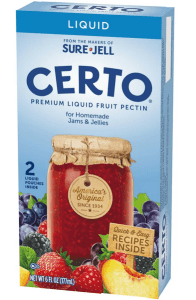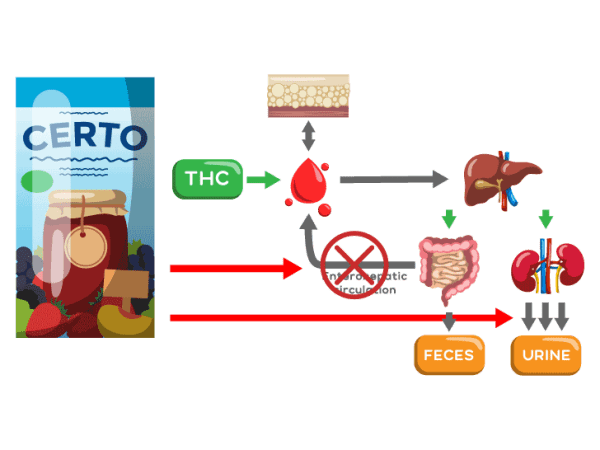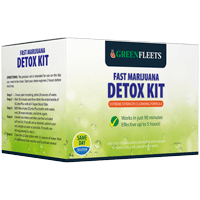You might have heard whispers online or from friends about using Certo, a common household fruit pectin, as a quick fix for passing a urine drug test. There’s a theory behind why it *might* work, based on how the body processes substances like THC.
However, let’s be upfront: this method is far from foolproof, and reviews are decidedly mixed. It carries significant risks, not just of failing the test, but also potentially triggering flags for sample tampering or dilution.
In this guide, we’ll walk through how people attempt the Certo method, explain the theory behind it, discuss why it’s unreliable, and cover some potentially more dependable (though still context-dependent) alternatives.
How People Attempt the Certo and Gatorade Method: Step-by-Step
Timing is considered crucial by proponents of this method. They typically aim to start the process 2-4 hours before the scheduled drug test, believing it takes 1-2 hours for the effects to begin.
The idea is that any potential masking effect Certo might offer peaks around 2 hours after consumption and could last up to 5 hours. Again, this timing is based on anecdotal reports, not robust scientific study.
Step-by-Step Instructions (Commonly Circulated Versions)
It’s important to understand these are instructions people *follow*, not a guaranteed recipe for success. Variations exist, often depending on perceived usage levels.
For lighter/occasional users (as rumored):
- Mix one packet of Certo fruit pectin thoroughly with a standard bottle of Gatorade (or similar electrolyte drink). Drink this mixture roughly 2-3 hours before the test.
- Drink water and urinate at least 2-3 times *before* leaving for the test location. The goal here is flushing the bladder.
- Some instructions suggest drinking another bottle of Gatorade about an hour before the test, possibly to help with hydration and specific gravity.
For heavier/regular users (a more involved rumored approach):
- (Optional) Some users drink a Certo/electrolyte mix the night before the test, hoping to start the process early.
- About 6 hours before the test, take 10 grams of creatine monohydrate. (Alternatively, 10 grams of creatine ethyl ester 3 hours before). This is an attempt to boost creatinine levels in the urine, which labs check to detect dilution.
- About 3 hours before the test, take a B-vitamin complex (like B2 or B12, often around 100-200mg). This is intended to add yellow color back to potentially diluted urine.
- Mix a packet of Certo thoroughly with about 27-32 oz of Gatorade or another sports drink. Drink this 2-4 hours before the test.
- Continue drinking water, perhaps another 30 oz or so, spread out before the test.
- Urinate frequently to flush the system.
- Crucially, proponents strongly recommend using an at-home drug test kit *before* going to the actual test to see if the method *appears* to be working for you on that day. This also helps gauge dilution.
Tips Sometimes Shared to Improve Chances (Use with Extreme Caution)
While the core method involves Certo and fluids, some additional tips circulate online. Remember, none of these guarantee success and add complexity to an already unreliable method:
- Pre-Test Night Prep? As mentioned, some drink Certo the night before, theorizing it helps clear metabolites from the intestines earlier.
- Drink Choice: While Gatorade is popular due to sugar and electrolytes, any sports drink (Powerade, BodyArmor, etc.) is often used. The goal is replacing electrolytes lost through frequent urination and potentially helping maintain specific gravity.
- Liquid Amounts: The amount of liquid needed likely varies hugely based on body weight, metabolism, usage habits, and test sensitivity. This is a major reason for the method’s unreliability. Doing “practice runs” at home with test strips (both drug and validity strips checking creatinine/specific gravity) is something users do to try and dial it in, but results can still vary on the actual test day.
- Morning Diet: Eating carb-heavy foods (pasta, bread, sugary snacks) on the morning of the test is sometimes suggested. The theory is that spiking insulin levels might slow the breakdown of body fat, temporarily reducing the release of stored THC metabolites into the bloodstream.
The Theory: How is Certo *Supposed* to Help Pass a Drug Test?
To understand the Certo theory, we need a quick look at how THC (the primary psychoactive compound in marijuana) is processed by the body.
When marijuana is consumed, THC enters the bloodstream and travels to the liver. The liver metabolizes THC into various metabolites. These metabolites are the primary substances drug tests look for, not necessarily THC itself. These metabolites are then eliminated from the body primarily through two routes: feces (via bile secreted into the intestines) and urine.
Interestingly, a larger portion of THC metabolites (estimated around 60-70%) are actually excreted into the intestines via bile. A smaller portion (around 20-30%) goes to the bladder for urine excretion. A complication is enterohepatic circulation: some of the metabolites secreted into the intestines can be reabsorbed back into the bloodstream, prolonging their presence in the body and potentially ending up back in the urine.
Why Does Marijuana Linger in the System?
THC is highly lipophilic, meaning it loves fat. It gets stored in the body’s fat tissues. As the body naturally burns fat for energy, stored THC and its metabolites are slowly released back into the bloodstream over time. This slow release from fat stores is why THC can be detectable in urine for days, weeks, or even months after last use, especially for frequent users.
What is Certo?

Certo (and similar products like Sure-Jell) is simply fruit pectin, a type of soluble fiber derived from fruits. Its primary household use is as a gelling agent for making jams and jellies.
It’s this high-fiber, gelling nature that forms the basis of the theory for its use in trying to pass drug tests.
How the Certo Method Theoretically Works (and the Flaws)

The Certo method is essentially a combination of dilution and a theoretical attempt to interfere with metabolite excretion:
- Attempted Intestinal Binding: The core theory is that the high soluble fiber content of pectin (Certo) might bind to bile acids in the intestines. Since THC metabolites are excreted via bile, the idea is that Certo traps these metabolites, preventing their reabsorption (enterohepatic circulation) and promoting their excretion through feces instead of urine. Crucially, there’s limited direct scientific evidence to prove pectin effectively binds THC metabolites in humans *to the extent needed* to significantly lower urine concentrations reliably.
- Dilution via Fluid Intake: Drinking large amounts of liquid (Gatorade, water) dilutes the urine, lowering the concentration of drug metabolites. If the concentration drops below the test’s cutoff level, it might result in a negative reading. However, excessive dilution is easily detected by labs.
- Attempting to Mask Dilution (Sugar, Electrolytes, Creatine, B-Vitamins):
- Sugar/Carbs: The sugar in Gatorade (or carbs eaten) spikes insulin, which proponents hope slows fat breakdown, theoretically reducing the release of stored THC into the blood and subsequently urine for a short period.
- Electrolytes (Gatorade): Labs check urine specific gravity (density) to detect dilution. Sports drinks contain electrolytes (minerals) that might help keep specific gravity within the acceptable range, despite high fluid intake.
- Creatine Supplementation: Labs also check for creatinine, a waste product of muscle metabolism, normally excreted at a steady rate. Diluted urine has low creatinine. Taking creatine supplements hours before is an attempt to artificially boost urine creatinine levels back into the normal range.
- B-Vitamins: These are taken solely to add yellow color back to pale, diluted urine, making it look less suspicious.
In essence, the method tries to temporarily flush the bladder with diluted urine while simultaneously attempting to reduce the amount of new metabolites entering the urine from both the bloodstream (via slowed fat burning) and intestinal reabsorption (via pectin binding), all while trying to mask the dilution itself from lab validity checks.
Does Certo Sure Gel Work for Opiates or Other Substances?
The *theory* behind Certo primarily targets the enterohepatic circulation pathway, which is significant for THC. While other drugs and their metabolites are also excreted via urine and feces, their metabolic pathways and reliance on bile excretion can differ significantly.
The dilution aspect (drinking lots of fluids) would temporarily lower the concentration of *any* substance in the urine. So, in theory, it might briefly lower metabolite concentrations for opiates, cocaine, etc., below cutoff levels. However, the pectin-binding theory is less applicable, and the overall unreliability remains.
Important Note: This method, relying heavily on dilution, will also flush out any prescription medications you are legitimately taking. If the test is looking for those (e.g., adherence testing), they might not show up, causing other problems.
The Big Downside: Results Are NOT Guaranteed, Risks Are Real
While the process described above might sound somewhat plausible on paper, the real-world effectiveness of the Certo method is highly questionable and inconsistent. Its success likely depends heavily on:
- Individual metabolism
- Frequency and amount of drug use
- Time since last use
- Body mass index (BMI)
- The sensitivity of the specific drug test being used
- Exact timing and execution of the method
What seems to work for one person might completely fail for another.
Key Risks and Drawbacks:
- Failure & Consequences: The most obvious risk is simply failing the drug test, which could lead to job loss, denial of employment, or violation of probation terms.
- Detection of Dilution: Even if metabolite levels are low, labs routinely perform validity checks. Urine that is too dilute (low specific gravity, low creatinine) will be flagged. While the method attempts to counteract this with creatine and electrolytes, it’s easy to get the balance wrong. A flagged sample might be considered a fail or require a re-test under supervision.
- Timing Errors: The supposed “window of opportunity” is narrow and based on guesswork. Mistiming could mean the effect hasn’t started or has already worn off.
- Health Risks: Drinking excessive amounts of fluid in a short period can lead to water intoxication (hyponatremia), a dangerous condition. Consuming large amounts of sugar (from Gatorade) can be problematic, especially for individuals with diabetes or insulin resistance.
- False Sense of Security: Relying on an unreliable method can lead to poor decisions.
I cannot stress this enough: if passing this drug test is critical, relying solely on the Certo method is a significant gamble. Doing “dry runs” at home with validity test strips and drug test strips is highly recommended by those who attempt this, just to get a *personal* sense of how their body responds, but even this doesn’t guarantee success on the actual test day.
Consider the stakes. Is potentially losing a job or facing legal issues worth the risk of using an unproven method? Don’t risk your future lightly.
Potentially More Reliable Alternatives (Consider with Caution)
Given the unreliability and risks of the Certo method, if facing a drug test, you might explore other options. Each has its own set of procedures, costs, and potential drawbacks.
Fast Marijuana Detox Kits (Temporary Flush)

These commercially available kits operate on a similar principle to the Certo method’s dilution aspect but are professionally formulated. They aim to provide the right blend of fluids, vitamins, and minerals (like creatine) to dilute metabolites while keeping validity parameters (color, specific gravity, creatinine) within acceptable ranges for a short period (usually a few hours).
The Fast Marijuana Detox Kit is one such example, claiming effectiveness within an hour and lasting up to five hours. They are designed as a same-day solution.
Caveat: These kits are still temporary masking agents, not true detoxifiers. Their effectiveness can still vary, and they might be expensive.
Synthetic Urine
Using high-quality synthetic urine is often considered one of the most reliable methods for unsupervised tests, as it involves substituting a clean sample for your own. The biggest challenges are ensuring the synthetic urine contains all necessary markers (urea, uric acid, correct pH, specific gravity, creatinine) and, crucially, maintaining it at body temperature (90-100°F or 32-38°C) until submission.
Successfully sneaking it into the collection site without detection is also required.
For more details, you can read reviews and guides: Best Synthetic Urine and Fake Pee Kits to Pass Drug Test with Confidence.
Caveat: Requires careful preparation, risk of temperature failure, and getting caught submitting a fake sample often has severe consequences. Not viable for supervised tests.
Natural Detoxification (The Only True Way)
The only guaranteed way to pass a drug test naturally is to allow your body to completely metabolize and eliminate the substances. This involves abstaining from drug use for a sufficient period before the test.
The timeframe varies greatly depending on the drug, frequency of use, body fat, metabolism, and hydration levels (THC can take weeks or months for heavy users). You can potentially support this natural process through hydration, a healthy diet, and exercise (though avoid heavy exercise right before a test, as it can release stored THC).
This method requires time and abstinence. For more on supporting your body’s natural detox process: How to Detox From THC: Fast and Effective Detox Methods.
Caveat: Requires significant time, which may not be available before a scheduled test.
Conclusion: Weighing the Risks of the Certo Method
The Certo and Gatorade method is a widely discussed but highly controversial technique for attempting to pass urine drug tests. While there’s a *theoretical* basis involving fiber binding and dilution, its real-world effectiveness is inconsistent and unreliable.
It’s absolutely crucial to understand the significant risks involved: failing the test, having the sample flagged as adulterated or diluted, potential health issues from excessive fluid/sugar intake, and the severe consequences that can follow a failed test (job loss, legal issues).
If you’re considering this method, approach it with extreme caution. Understand it’s a gamble, not a guarantee. Doing practice runs at home with test strips might offer some insight but doesn’t ensure success on the day.
If the stakes are high – like a crucial job opportunity, probation requirement, or legal proceeding – relying on the Certo method is strongly discouraged. Exploring potentially more reliable (though still context-dependent) alternatives like professionally formulated same-day detox kits (understanding they are temporary masks), high-quality synthetic urine (for unsupervised tests, with careful handling), or allowing sufficient time for natural detoxification through abstinence are options to carefully consider based on your specific circumstances and risk tolerance.
Always prioritize your health, employment, and legal standing when making decisions related to drug testing.
